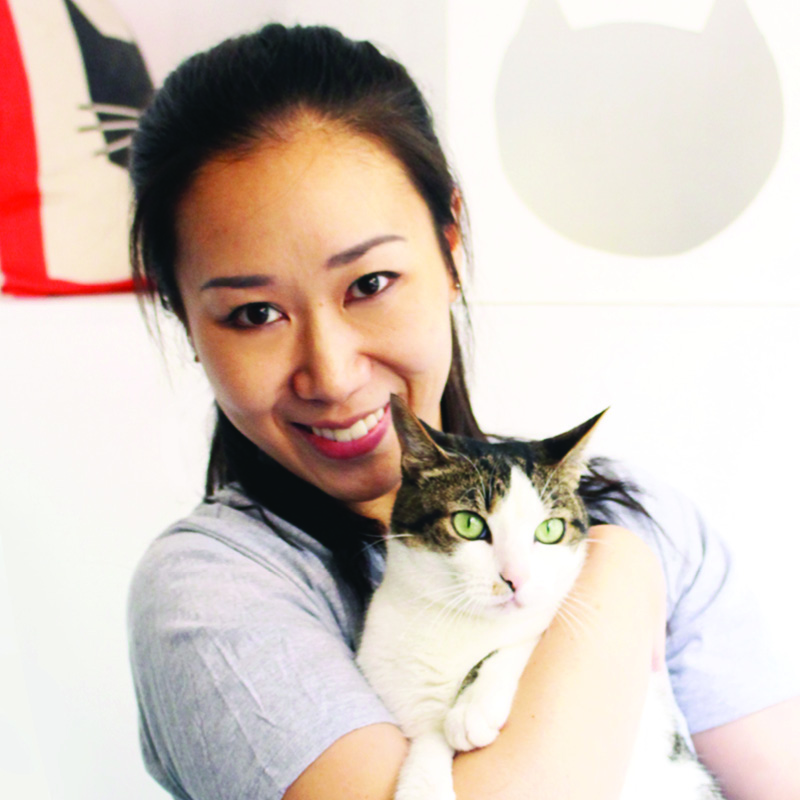
Interview! Christina Ha, Cat Camp & Meow Parlour Cat Café
May 24, 2019
Interview! Sarah Dunsmore, CDE Animal Cages
June 1, 2019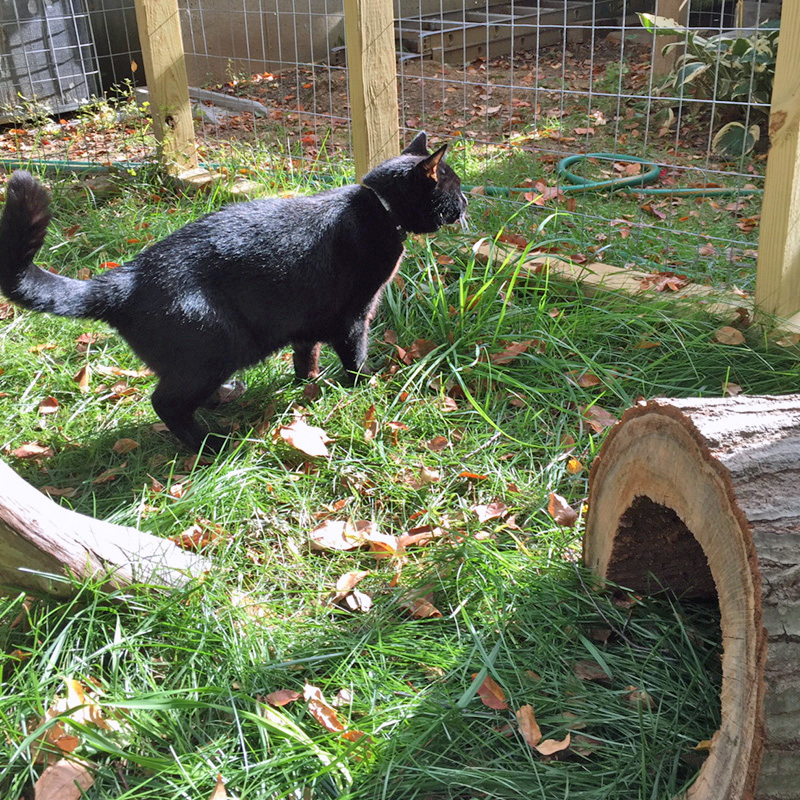
This week’s guest post comes to us from Liz Pease, former Executive Director of the Merrimack River Feline Rescue Society, who was featured on CCP Episode #51.
You’ve probably heard about catios (or “cat patios”).
Maybe your cats are even lucky enough to have a one! If not, it might be time to think about buying or building one. Not only are they a way to give your cat(s) a taste of the great outdoors while keeping them safe from the dangers out there, they also keep wildlife safe from your cats—plus, they ease some of the guilt many of us feel from keeping our cats as indoor-only pets.
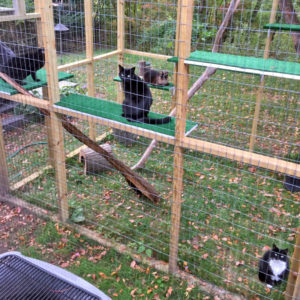 We all know cats need a lot of stimulation and playtime, but it can be hard to balance that with work and life commitments. Add in an indoor-only lifestyle, and it’s easy to understand why so many cats are bored and overweight. Boredom can lead to destructive habits and behavioral issues, and of course, obesity is a major health issue for our cats. A catio can be a great way to help keep your cats healthy and happy, all while keeping your neighborhood wildlife safe, and keeping you from worrying about your cats.
We all know cats need a lot of stimulation and playtime, but it can be hard to balance that with work and life commitments. Add in an indoor-only lifestyle, and it’s easy to understand why so many cats are bored and overweight. Boredom can lead to destructive habits and behavioral issues, and of course, obesity is a major health issue for our cats. A catio can be a great way to help keep your cats healthy and happy, all while keeping your neighborhood wildlife safe, and keeping you from worrying about your cats.
Where to start?
First, you’ll want to think about where you live: House? Condo? Apartment? Are there any restrictions on outside structures? How big can go you go without needing a building permit? Do you need something that can easily be taken apart when you move? How many cats do you have? Do you have just enough space to let them sniff the fresh air? Or can you go big and let them feel the grass beneath their feet and then climb from there? The sky is the limit as far as design goes, but cost, your skills, and your space will determine what you can actually do.
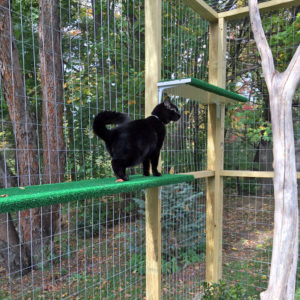
When I decided I wanted a catio, I had five cats, and I knew that I wanted them to be able to touch the actual ground, nibble on grass, and dig in the dirt and leaves. One of my cats, Harley, who has since passed away, was an avid fan of the outdoors, but after he disappeared on me for over 24 hours once, I knew I couldn’t keep taking the risk of letting him outside—but I also knew Harley would be miserable without some kind of access to the outdoors.
As I started thinking about what to build, I knew that because of the design and materials of our house, whatever I built couldn’t be attached directly to the house. I knew I wanted to be able to access the catio myself for cleaning/raking, in case of an emergency, or if I just wanted to go in and sit with the gang. I wanted the cats to have perches and some natural elements, and I wanted them to be able to come and go as they pleased. I have quite a bit of wildlife in my area, including fox, raccoons, and coyotes, so I knew I needed to make sure that the catio had extra safety precautions built in.
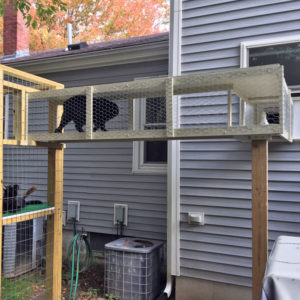 I set about looking for plans online and started buying materials a little at a time to make the project easier on my budget: a roll of chicken wire here, a roll of welded wire field fencing there. When the time came to build, my father agreed to do the construction. I am pretty handy, but I don’t have a lot of tools, or the lifetime of experience my dad has, so it was a relief to hand the project off to someone more skilled!
I set about looking for plans online and started buying materials a little at a time to make the project easier on my budget: a roll of chicken wire here, a roll of welded wire field fencing there. When the time came to build, my father agreed to do the construction. I am pretty handy, but I don’t have a lot of tools, or the lifetime of experience my dad has, so it was a relief to hand the project off to someone more skilled!
Once we determined the size we wanted, my dad dug down about a foot all around the perimeter of the catio area, then placed chicken wire into the hole, which would later be connected to the screening of the catio itself. This was to prevent animals from digging under and into the catio. Next, my dad constructed a frame of four walls and a roof out of pressure-treated 2x4s, with a bottom sill plate. He also framed in a door at one end of the catio. He attached welded wire field fencing around the sides and over the roof. Much stronger than chicken wire, the fencing can withstand a dog or similar animal running at it, but allows plenty of room for leaves (and other things! – more on that later!) to pass through.
Next, my dad added some shelves and perches and covered them with indoor/outdoor carpeting. Being the kind of guy who gets pretty elaborate with his projects, he took a few large tree branches and logs and secured them inside the catio for use as ramps and scratching posts. Finally, he constructed a tunnel that runs from a window out to the catio. It has a plywood roof and bottom and chicken wire sides. He installed a cat door in a plywood panel that was then installed into the window. All in all, the materials for the catio cost less than $400. My dad’s free labor was priceless, of course!
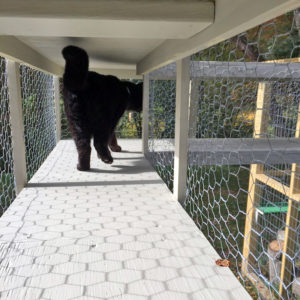 The catio has been up for two years now, and the cats have free access to it 24/7, all year round.
The catio has been up for two years now, and the cats have free access to it 24/7, all year round.
The only time I lock the door is when it is below 10 degrees or so. I have added a bush to the catio that I purchased off the season’s-end clearance table at Lowes, and when it is all leafed out, the cats love to sit under it. The more adventurous ones are out there in rain, sleet, and snow, while the most timid cat only seems to venture out on very quiet, clement early mornings. They have several birdfeeders nearby to watch, and a tree overhead provides shade in the summer. Birds sometimes fly through the catio when no cats are out there, and I’ve seen nuthatches pecking on one of the branches, and even recently had a Carolina wren who perched inside over the door, singing his heart out for a bit!
One unexpected thing has been the fact that mice, moles, and chipmunks do sometimes get into the catio—much to my cats’ delight. And because the cats can come into the house at will, this means that sometimes they make it inside with one of these critters. Just the other night, my cat Jet came trotting through the kitchen with a chipmunk in his mouth. Luckily, I was able to get them into the bathroom, and after opening a window, the chipmunk took off to safety. This has only happened a handful of times, however. Mostly my cats just enjoy lounging in the sun, hiding under the plants that grow up inside the catio over the summer, or getting to pee in the dirt!
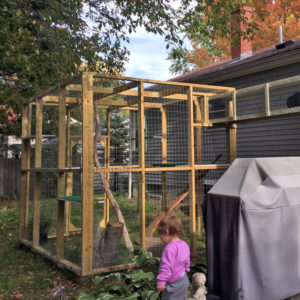 The catio takes up a lot of space in my very small yard, and now that I have two small kids, I wish it were a bit smaller, but I’m really glad to have it. The kids love to talk to the cats when they’re outside in the catio (and the cats seem much more at ease with the kids from inside the safety of their catio!), and it definitely eases my mind about the cats’ safety—and about their health and well-being.
The catio takes up a lot of space in my very small yard, and now that I have two small kids, I wish it were a bit smaller, but I’m really glad to have it. The kids love to talk to the cats when they’re outside in the catio (and the cats seem much more at ease with the kids from inside the safety of their catio!), and it definitely eases my mind about the cats’ safety—and about their health and well-being.
Inspired?
If you are considering a catio, I recommend that you visit Cats Safe at Home’s fantastic website. The site has all kinds of resources on building, buying, or hiring someone to build a catio, as well as general info on catios and lots of places to go for inspiration. Cats Safe at Home is a partnership between the Portland Audubon Society, the Feral Cat Coalition of Oregon, and several local county animal service agencies. Together, they advocate for the safety of cats and wildlife through the Cats Safe at Home campaign, which even runs an annual catio tour in Portland! In case you missed it, check out Stacy’s interview with Karen Kraus from the Feral Cat Coalition of Oregon and Bob Sallinger from the Portland Audubon Society on CCP Episode 262.

Article by Liz Pease. Liz Pease is a freelance writer, editor, and proofreader who spent over a decade at The Merrimack River Feline Rescue Society in Salisbury, MA, first as a program coordinator, then as director of operations, and finally as executive director. She lives in Salisbury with her 4 spoiled cats, her husband, and two young children.




